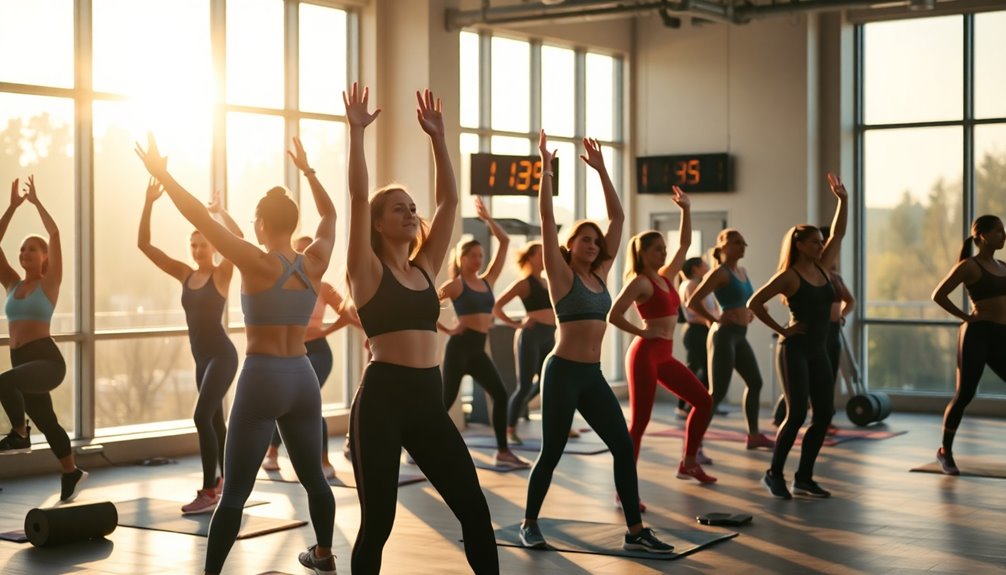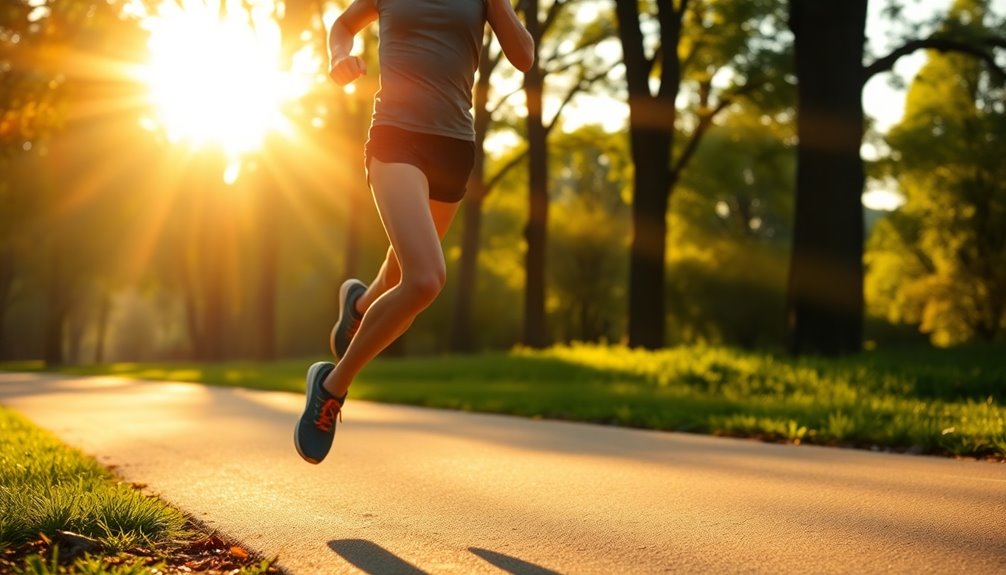To hit peak performance, time your workouts with your body’s natural circadian rhythms. Morning exercise boosts alertness, supports better sleep, and optimizes hormone levels, while afternoon sessions align with higher body temperatures and muscle flexibility for strength and endurance. Evening workouts can delay sleep but may support recovery if intensity is moderate. By syncing exercise with your internal clock and light exposure, you’ll enhance your results and overall well-being—discover how to perfect your schedule below.
Key Takeaways
- Schedule high-intensity workouts in the late afternoon (2–6 pm) to align with peak body temperature and hormone levels for optimal strength and power.
- Perform moderate exercise in the morning to reinforce sleep-wake cycles, improve sleep quality, and enhance alertness during the day.
- Avoid intense evening workouts close to bedtime to prevent sleep disruptions caused by elevated body temperature and adrenaline.
- Incorporate outdoor activity in the morning to maximize natural light exposure, which supports circadian entrainment and performance.
- Consistently exercise at the same time daily to strengthen circadian rhythms, boost energy, and improve overall physical performance.
Understanding the Body’s Circadian Clock and Exercise

Your body’s circadian clock is a biological system that regulates essential functions like hormone release, metabolism, and body temperature on a roughly 24-hour cycle. Exercise acts as a non-photic zeitgeber, meaning it can shift or entrain your circadian rhythm independently of light exposure. When you work out at different times, it can cause phase shifts—either advancing or delaying your internal clock—depending on when you exercise. The suprachiasmatic nucleus (SCN) in your hypothalamus is the central pacemaker, influenced by behavioral cues like physical activity. Exercise also affects clock gene expression in peripheral tissues, linking workout timing to molecular circadian regulation. Understanding this interaction helps you optimize your exercise schedule for better sleep, alertness, and overall health. Incorporating awareness of cultural intelligence in your routine can enhance your ability to adapt to diverse environments and schedules, maximizing the benefits of exercise at different times. Additionally, acknowledging individual differences in chronotype can further personalize exercise timing for optimal performance and recovery. Recognizing how exercise timing influences your internal clock allows for more effective planning of your workouts to align with your natural rhythms for improved results. Moreover, considering sleep quality alongside workout timing can significantly boost overall well-being and recovery. Research also suggests that behavioral cues like activity patterns play a crucial role in maintaining circadian stability, reinforcing the importance of consistent routines.
How Morning Workouts Boost Sleep and Energy Levels

Morning workouts set the tone for a more restful night by signaling your body to be alert and active during the day, which helps reinforce a consistent sleep schedule. Exercising in the morning helps balance hormones, making it easier to fall asleep and stay asleep. Exposure to natural light during your workout raises melatonin levels at night, improving sleep quality. Studies show that morning exercise leads to longer, deeper sleep and fewer nighttime awakenings. It also helps regulate your circadian rhythms, aligning them with natural light-dark cycles. Circadian rhythm plays a crucial role in determining your sleep-wake patterns and overall health. Narcissistic traits can sometimes influence how individuals perceive their own activity levels and motivation, impacting their workout habits. Plus, morning workouts boost your energy by jump-starting your metabolism and stabilizing blood sugar. This increased alertness can last all day, making you more productive, while better sleep enhances overall health and recovery.
The Benefits of Afternoon Exercise for Cognitive and Physical Performance

Exercising in the afternoon offers notable benefits for both physical and cognitive performance, thanks to the body’s natural circadian fluctuations. During this time, your body temperature peaks, enhancing muscle flexibility, enzyme activity, and nerve conduction, which boost strength and power. Metabolic functions also improve, leading to better energy use and reduced injury risk due to increased joint mobility. Studies show that strength and power output are highest between 2 pm and 6 pm, aligning with hormonal shifts that favor muscle recovery and performance. Additionally, a well-timed nap around 2 pm can further boost mental alertness and physical recovery, making afternoon exercise an *ideal* choice for peak performance. Incorporating proper nutrition before and after workouts can also optimize energy levels and support recovery during this peak time. Understanding your body’s circadian rhythm can help tailor your exercise schedule for maximum effectiveness. Recognizing individual circadian patterns allows for personalized workout timing, further enhancing results. Engaging in outdoor activities during this period can also provide the added benefit of natural light exposure, which supports overall circadian health.
Managing Evening Exercise to Support Restful Sleep

While afternoon workouts can boost performance and mental clarity, exercising too close to bedtime can interfere with your sleep quality. High-intensity evening exercises, especially within four hours of sleep, can delay sleep onset and reduce sleep depth. Elevated body temperature and heart rate from strenuous activity make it harder to fall asleep and can disrupt sleep cycles. Large-scale studies show that late-evening workouts increase resting heart rate and lower heart rate variability during sleep, negatively affecting recovery. To support restful sleep, consider lowering exercise intensity or finishing workouts earlier in the evening. Incorporate cool-down routines to help lower your body temperature and heart rate. Creating a comfortable sleep environment and maintaining a consistent schedule further promote better sleep after evening workouts. Additionally, just like glycolic acid can improve skin texture and promote cell renewal, adjusting your exercise timing can enhance your overall recovery and well-being. Being mindful of your circadian rhythm can help optimize your exercise routine for better health and performance. For instance, understanding how body temperature regulation influences sleep can guide you in planning the best workout times. Incorporating sleep hygiene practices can also make a significant difference in achieving restful sleep post-workout and understanding headphone compatibility can help you enjoy your exercise sessions without interruption.
The Role of Consistent Workout Timing in Circadian Regulation

Maintaining a consistent workout schedule can substantially influence your circadian rhythm by aligning your body’s internal clock with external routines. When you exercise regularly at the same time, it helps synchronize your biological processes, potentially boosting performance and reducing sleep disruptions. Consistent timing improves cardiovascular efficiency, metabolic health, and mental focus, ensuring you’re physically and mentally prepared for each session. It also supports the regulation of your internal biological rhythms, contributing to overall well-being. Personalized workout timing based on your chronotype—whether you’re a morning lark or a night owl—can further optimize these benefits. Additionally, choosing a preppy dog name that reflects your personality can help reinforce your routine and boost your motivation. Establishing a habit formation routine reinforces your body’s natural circadian patterns, making it easier to maintain energy levels, recover effectively, and achieve peak performance consistently. Incorporating consistent exercise timing into your daily schedule can also enhance sleep quality and duration, further supporting your circadian health. Moreover, integrating automation in your training schedule can help you stay committed and consistent over time.
How Exercise Can Shift Your Internal Biological Phases

Exercise serves as a powerful non-photic zeitgeber that can shift your circadian rhythms, much like exposure to light does. When you work out at different times of day, it influences your internal clock’s timing and direction. Morning exercise tends to advance your circadian phase, helping you wake earlier, while evening workouts can delay it, making you feel sleepy later. These shifts happen through changes in your central and peripheral clocks, affecting tissues like muscles and liver. Exercise impacts clock gene expression, hormonal signals like cortisol, and body temperature, all of which help reset your internal timing. The intensity, duration, and your baseline rhythm determine how much your internal clocks adjust, ultimately improving synchronization with your environment and enhancing overall well-being. Additionally, exercise timing can influence sleep quality and duration, further supporting your circadian health. Incorporating essential oils for sleep into your routine may also promote relaxation and improve sleep, complementing the effects of exercise timing.
Optimizing Sleep Quality Through Exercise-Induced Rhythmic Changes

Timing your workouts can markedly influence your sleep quality by aligning your internal clock with the natural day-night cycle. Exercising in the morning boosts melatonin levels in the evening, helping you fall asleep faster and improve sleep quality. It also encourages better circadian alignment by shifting your internal rhythms to match daylight hours, making sleep more restorative. Consistent morning routines reinforce a steady sleep-wake cycle, reducing sleep latency and promoting regular sleep patterns. While evening workouts can disrupt sleep, daytime exercise, especially in the morning, strengthens circadian signals without interfering with rest. Moderate-intensity exercise is ideal, offering sleep benefits without overstimulating your body. Regular, well-timed physical activity creates a cumulative effect, supporting sustained improvements in sleep quality and overall circadian rhythm health.
Physiological Responses: Body Temperature, Hormones, and Sleep Cues

Your body’s physiological responses to exercise vary considerably depending on the time of day, shaping how your body temperature, hormones, and sleep cues interact. Core temperature peaks late afternoon (around 4–6 PM), boosting muscle strength and performance. Morning workouts occur during lower body temperatures, reducing perceived effort but limiting peak anaerobic capacity. Evening exercise aligns with higher muscle temperature, enhancing flexibility, power, and injury resilience, though it may delay melatonin onset if too close to bedtime. Hormone fluctuations also influence responses: cortisol and testosterone peak in the morning, supporting energy and muscle synthesis, while growth hormone released after evening exercise aids recovery. Additionally, epinephrine and norepinephrine increase in the evening, boosting fat oxidation and endurance. These rhythms shape how your body adapts and performs throughout the day.
Combining Light Exposure and Exercise for Better Circadian Alignment

Light exposure is a primary factor in regulating circadian rhythms, acting as the body’s most influential cue, or zeitgeber. When combined with exercise, these signals can work together to better entrain your internal clock. Bright light and exercise both independently induce phase shifts—advancing or delaying your rhythm—depending on timing. If timed correctly, their interaction can produce larger shifts, especially during phase-delay periods, helping you adapt to night shifts or jet lag. Morning outdoor exercise maximizes natural light, promoting circadian advancement. Conversely, exercising in the evening with light exposure can delay your rhythm if needed. Understanding how light and exercise timing interact allows you to strategically align your routines for optimal circadian well-being and performance.
Tips for Incorporating Exercise to Maintain a Healthy Body Clock

Incorporating exercise into your daily routine can markedly support a healthy body clock, especially when you consider the best times to work out. Morning workouts help regulate your circadian rhythm and boost wakefulness, making it easier to stay alert throughout the day. If you’re an evening person, exercising later can align with your natural peak performance, typically between 2 pm and 6 pm. However, avoid intense workouts close to bedtime, as they can delay sleep. Moderate exercise is generally less disruptive and easier to incorporate regularly. Personalize your schedule based on your chronotype, and aim for consistency. Regular, well-timed exercise can stabilize your circadian rhythm, improve overall health, and enhance both physical and mental performance.
Frequently Asked Questions
Can Exercise Timing Help Reset Disrupted Circadian Rhythms From Shift Work?
You might wonder if exercise timing can help reset your disrupted circadian rhythms from shift work. The answer is yes; exercising at the right times can promote circadian realignment. Morning workouts tend to advance your internal clock, while evening sessions may delay it, depending on your chronotype. By strategically timing your exercise, you can improve sleep, boost energy, and better adapt to irregular schedules, enhancing overall health.
Does Exercise Intensity Influence How Effectively It Shifts Your Internal Clock?
You might think intensity doesn’t matter much, but it actually influences how your internal clock shifts. Higher intensity workouts, especially in the morning, can help you advance your circadian rhythm, making you feel sleepier earlier. Evening vigorous exercise, however, may delay your rhythm. So, if you want a more effective shift, focus on the right intensity at the right time, tailoring it to your goals and chronotype.
How Quickly Can Exercise Adapt Your Circadian Rhythm After Jet Lag?
You wanna know how fast exercise can reset your internal clock after jet lag. Usually, consistent moderate-to-high intensity workouts over about a week can markedly realign your circadian rhythm, often within 7 days. The key is daily exercise, ideally timed after your core body temperature minimum, combined with light exposure or melatonin. Regular, properly timed workouts help your body adapt faster, easing symptoms and restoring your natural sleep-wake cycle efficiently.
Are There Differences in Circadian Effects Between Aerobic and Anaerobic Workouts?
Did you know that anaerobic performance peaks around 2 p.m., while aerobic performance varies more throughout the day? You’ll find that anaerobic workouts, like sprinting or lifting, are best in the late morning or early afternoon due to body temperature rises. In contrast, aerobic activities often peak later, influenced by factors like oxygen saturation and metabolic efficiency. Understanding these differences helps you time workouts for ideal results.
What Role Does Age Play in Exercise’S Impact on Circadian Rhythm Regulation?
You should know that age crucially influences how exercise impacts your circadian rhythm. As you get older, your internal clock shifts earlier, and rhythms weaken. Regular physical activity can help counteract these changes by improving rhythm amplitude and stability, especially in organs like the kidneys. Moderate-to-high intensity exercise, done consistently, supports better sleep, hormone regulation, and overall circadian health, helping you maintain vitality and well-being as you age.
Conclusion
By syncing your workouts with your body’s natural clock, you turn exercise into a finely tuned dance that boosts your energy, sharpens your mind, and helps you sleep peacefully. Think of your circadian rhythm as a symphony—when you time your workouts just right, everything harmonizes beautifully. So, listen to your body’s cues, stay consistent, and let exercise be the conductor guiding you toward peak performance and restful nights.









